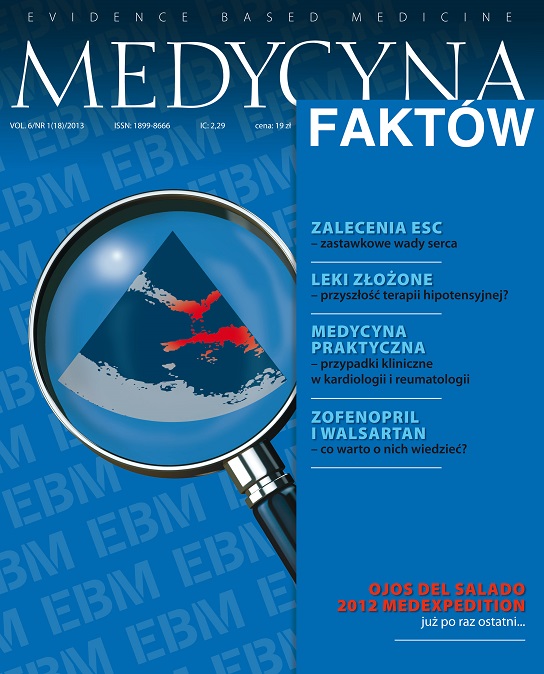Heart failure – how can we further enhance pharmacotheraphy? Case report
Main Article Content
Abstract
Patients with chronic heart failure, particularly with impaired left ventricular systolic function benefit from the reduction of the resting heart rate below 70/min., which has been proven in numerous clinical studies. SHIFT study has shown that adding ivabradine to the therapy of patients with difficulties in obtaining resting heart rate control despite of usage of betablockers in the maximum dose, or if the increase of β-blocker dose is contraindicated. The paper presents two clinical cases of patients receiving ivabradine that effectively reduced resting heart rate. In the first case, 73-year-old woman with chronic ischemic heart failure with impaired systolic function of the left ventricle (EF 30%) receiving β-blockers at the maximum dose did not achieve the desired release of the heart rate and adding ivabradine to the therapy allowed to gain the expected clinical effect. In the second case of 64-year-old woman also with ischemic chronic heart failure, obesity and COPD, not tolerating high doses of β-blocker use of ivabradine was associated with effective decrease of the heart rate.
Article Details
Copyright © by Medical Education. All rights reserved.
References
2. Fox K., Ford I., Steg P.G. et al.; BEAUTIFUL investigators: Heart rate as a prognostic risk factor in patients with coronary artery disease and left-ventricular systolic dysfunction (BEAUTIFUL): a subgroup analysis of a randomised controlled trial. Lancet 2008; 372: 817-821.
3. Kolloch R., Legler U.F., Champion A. et al.: Impact of resting heart rate on outcomes in hypertensive patients with coronary artery disease: findings from the INternationalVErapamil-SR/trandolaprilSTudy (INVEST). Eur. Heart J. 2008; 29: 1327-1334.
4. Böhm M. , Swedberg K., Komajda M., et al., on behalf of the SHIFT Investigators: Heart rate as a risk factor in chronic heart failure (SHIFT): the association between heart rate and outcomes in a randomised placebo-controlled trial. Lancet 2010; 376: 886-894.
5. Böhm M., Borer J., Ford I. et al.: Heart rate at baseline influences the effect of ivabradine on cardiovascular outcomes in chronic heart failure: analysis from the SHIFT study. Clin. Res. Cardiol. [online: DOI 10.1007/s00392-012-0467-8].
6. Komajda M., Böhm M., Borer J. et al.: Influence of background treatment with mineralocorticoid receptor antagonists on ivabradine’s effects in patients with chronic heart failure. European Journal of Heart Failure [online: doi:10.1093/eurjhf/hfs127].
7. Christensen L.P., Zhang R., Zheng W. et al.: Postmyocardial infarction remodeling and coronary reserve: effects of ivabradine and beta blocade therapy. Am. J. Physiol. Heart Circ. Physiol. 2009; 297: H322-H330.
8. ESC Guidelines for the diagnosis and treatment of acute and chronic heart failure 2012; The Task Force for the Diagnosis and Treatment of Acute and Chronic Heart Failure 2012 of the European Society of Cardiology Developed in collaboration with the Heart Failure Association (HFA) of the ESC. Eur. Heart J. 2012; 33: 1787-1847.
9. Jankowska E.A., Kurian B., Banasiak W., Ponikowski P.: Are there relationships between high resting heartrate and not optimal doses of betablockers inoutpatients with systolic heart failure incontemporary Poland? Results of DATA-HELP study. Eur. Heart J. 2012; 33(Suppl. 1): 808.

